- Home
- Flora and Fauna
- Tenerife Flora
Tenerife Flora - plants, flowers and trees endemic to the island
that I'm associated with.
Learn more
Tenerife flora. Because it is a little isolated in the Atlantic Ocean, Tenerife has a selection of indiginous, or endemic, plants, flowers and trees. These two terms literally mean "belonging exclusively to a particular place", so, on this page, you won't find species that have been artificially introduced from elsewhere by humans.
Let's start with, possibly, the more well-known examples.
The Dragon Tree
Tenerife, specifically Icod de Los Vinos, is famous for its Dragon Tree, considered a major tourist attraction.
| This particular species of the tree, dracaena draco, isn't only indiginous to Tenerife, but the whole of the Canary Islands, plus all the other islands making up the area known as Macaronesia. These trees can live to be hundreds of years old. Indeed, the famous one at Icod is thought to be over 1000 years old, but that's probably a bit of an exaggeration. | 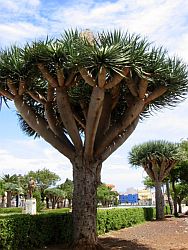 Photo: Jose Mesa |

Photo: Jose Mesa
They are characterised by having several intertwining trunks, forming a thick, central stem, rising to end in an umbrella-like canopy of thick leaves.
Once extensively "farmed" for their red sap, known as "dragon's blood", they are now a protected species.
Canarian Pine Tree
Pinus Canariensis is the pine tree that forms the forests around the slopes of Mount Teide, that you have to travel through to get to the peak.
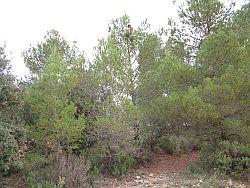 Photo: Carlesmari | These trees usually grow up to 40 metres tall, but some as high as 60 metres have been recorded. They thrive in cooler areas and don't rely too much on rainfall, due to the properties of their needles, which have the ability to capture moisture from the air and from mist. They are also extremely fire resistant, which is why a forest fire in Tenerife is a very rare event. |

Photo: Carlesmari
These trees usually grow up to 40 metres tall, but some as high as 60 metres have been recorded. They thrive in cooler areas and don't rely too much on rainfall, due to the properties of their needles, which have the ability to capture moisture from the air and from mist. They are also extremely fire resistant, which is why a forest fire in Tenerife is a very rare event.
The Teide Violet
This unassuming flower, viola cheiranthifolia, is found only on the upper, rocky slopes of Mount Teide. It is quite rare and, as it only grows a few inches tall, is very difficult to spot.
The conditions in which it exists are dry and cold, but, survive it does.
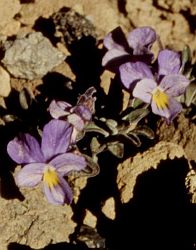
Photo: Sebastian Fischer
tenerife flora
Canarian Palm
| The Canarian palm, palmera canariensis, is the only species of palm tree found on Tenerife. It has a long, straight trunk, culminating in a full spray of leaves at the top. Growing to a maximum height of about 12 metres, it yields small, oval-shaped fruits called tamanares. These edible items are similar to dates, but are not generally cultivated. | 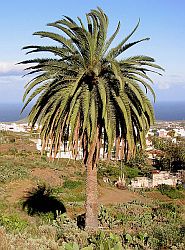 Photo: Mataparda |
The Canarian palm, palmera canariensis, is the only species of palm tree found on Tenerife. It has a long, straight trunk, culminating in a full spray of leaves at the top. Growing to a maximum height of about 12 metres, it yields small, oval-shaped fruits called tamanares. These edible items are similar to dates, but are not generally cultivated.

Photo: Mataparda
Tenerife Cactus (Tunera & Penca)
These are the two most common types of cactus found on the island. Known, by their Latin names, as opuntia ficus-barbarica and opuntia dillenii, these two species are, perhaps, not truly indiginous to Tenerife, as they originated in Mexico.
The first type is characterised by long, ridged spines, usually in groups of three, whereas the second is arranged in larger groups of short spines.
Both yield the prickly pear fruit and can usually be found on wasteground and near cultivated areas.
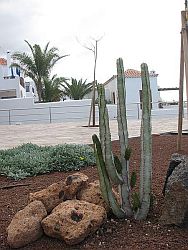 Photo: Joe Anderson | 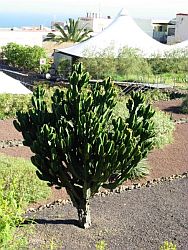 Photo: Piotrus |
Almond Tree
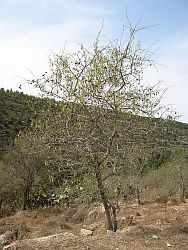 | This tree, prunus dulcis, is found most frequently on the western slopes of the island's mountains. Only growing to as much as 10 metres, it produces its yield of almonds by about autumn. Technically a fruit tree, as opposed to a nut, it sheds its leaves annually. |

This tree, prunus dulcis, is found most frequently on the western slopes of the island's mountains. Only growing to as much as 10 metres, it produces its yield of almonds by about autumn. Technically a fruit tree, as opposed to a nut, it sheds its leaves annually.
tenerife flora
Bejeque
| "Bejeque" is the local name for this plant, aeonium urbicum and there are some 30 varieties throughout the Canary Islands. They have woody stems, terminating in a sort of florette of thick, green leaves. On some of these plants, you may detect a red tinge on the edge of the leaves. | 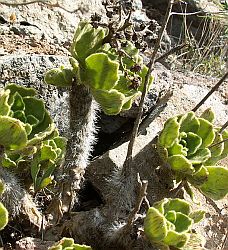 Photo: Opuntia |
"Bejeque" is the local name for this plant, aeonium urbicum and there are some 30 varieties throughout the Canary Islands. They have woody stems, terminating in a sort of florette of thick, green leaves. On some of these plants, you may detect a red tinge on the edge of the leaves.

Photo: Opuntia
Tajinaste
| This might be a familiar looking shrub, even if the name is strange. Covered by the Latin term echium wildpretii, this plant is found in large numbers in the Las Cañadas caldera. It can grow to heights of three metres and, although prefering warm, dry conditions, can withstand frosts of up to -15 degrees centigrade. It is a true indiginous species of Tenerife, flowering late spring to early summer. | 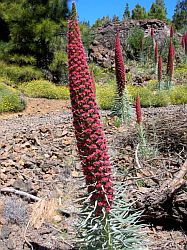 Photo: Grombo |
This might be a familiar looking shrub, even if the name is strange. Covered by the Latin term echium wildpretii, this plant is found in large numbers in the Las Cañadas caldera. It can grow to heights of three metres and, although prefering warm, dry conditions, can withstand frosts of up to -15 degrees centigrade. It is a true indiginous species of Tenerife, flowering late spring to early summer.

Photo: Grombo
Tabaiba Mejorera
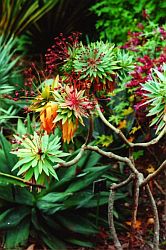 Photo: Density | This pretty plant is found in the south and west of Tenerife, confined to altitudes between 300 and 1,200 metres, where the conditions are quite humid. It can grow to heights of two metres and the dark red flowers appear between December and May. |

Photo: Density
This pretty plant is found in the south and west of Tenerife, confined to altitudes between 300 and 1,200 metres, where the conditions are quite humid. It can grow to heights of two metres and the dark red flowers appear between December and May.
tenerife flora
Canary Island Spurge
| It's a good name, isn't it - spurge! There are many different types of spurge and there is one native to the Canary Islands. Euphorbia canariensis looks, at first glance, like a cactus. It certainly is similar in appearence, with a square trunk that can grow up to four metres. It has no "leaves" to speak of, just thorns. Known locally as "Cardon", it is found mainly in dry, lower areas of Tenerife. It displays both green and red flowers. | 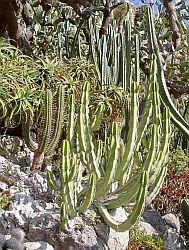 Photo: Frank Vincentz |
It's a good name, isn't it - spurge! There are many different types of spurge and there is one native to the Canary Islands. Euphorbia canariensis looks, at first glance, like a cactus. It certainly is similar in appearence, with a square trunk that can grow up to four metres. It has no "leaves" to speak of, just thorns. Known locally as "Cardon", it is found mainly in dry, lower areas of Tenerife. It displays both green and red flowers.

Photo: Frank Vincentz
Purple Daisy
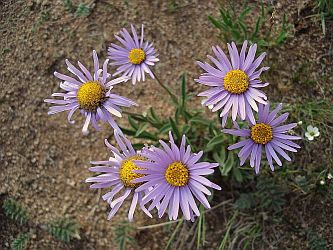 Photo: Imartin6 | A true, endemic species of Tenerife, this member of the daisy/sunflower family (pericallis echinatapericallis echinata) is found in humid areas of the island. It can reach up to 50 centimetres in height, with flowers of up to 2.5 centimetres diameter. |

Photo: Imartin6
A true, endemic species of Tenerife, this member of the daisy/sunflower family (pericallis echinatapericallis echinata) is found in humid areas of the island. It can reach up to 50 centimetres in height, with flowers of up to 2.5 centimetres diameter.
Margarita
| This particular variety of white daisy is endemic to Tenerife. Argyranthemum foeniculaceum is characterised by strong stems, with doubly layered leaves, the flowers are yellow with white petals. | 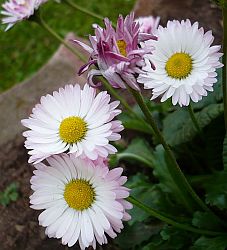 Photo: Gonzalo Rivero |
This particular variety of white daisy is endemic to Tenerife. Argyranthemum foeniculaceum is characterised by strong stems, with doubly layered leaves, the flowers are yellow with white petals.

Photo: Gonzalo Rivero
tenerife flora
Red Poppy
| This plant, papaver rhoeas, is, obviously, found elsewhere in Europe, hence its other names, "Flanders Poppy" and "Corn Poppy". It is, essentially, a weed and grows wild in Tenerife, being seen during spring. They may be found anywhere where fields have been tilled and usually flower before the cereal crop in question has been harvested. | 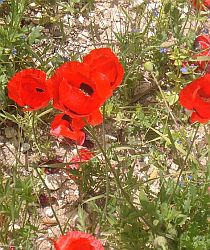 |
This plant, papaver rhoeas, is, obviously, found elsewhere in Europe, hence its other names, "Flanders Poppy" and "Corn Poppy". It is, essentially, a weed and grows wild in Tenerife, being seen during spring. They may be found anywhere where fields have been tilled and usually flower before the cereal crop in question has been harvested.

California Poppy
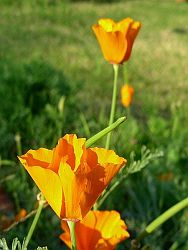 | As its name suggests, this plant is native to the western United States, but may be found growing wild in the uplands of south Tenerife. Known as eschscholzia californica, it flowers during spring and can often be seen at the side of footpaths and on waste ground. |

As its name suggests, this plant is native to the western United States, but may be found growing wild in the uplands of south Tenerife. Known as eschscholzia californica, it flowers during spring and can often be seen at the side of footpaths and on waste ground.
Canarian Buttercup
| The Canarian buttercup, or ranunculus cortusifolius, is found not only on the Canary Islands, but also other islands of the Macaronesia group, the Azores and Madeira. With long stems topped with bright yellow flowers, they prefer moist soil and bloom in late autumn. | 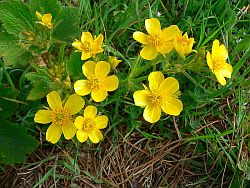 Photo: Marianne Perdomo |
The Canarian buttercup, or ranunculus cortusifolius, is found not only on the Canary Islands, but also other islands of the Macaronesia group, the Azores and Madeira. With long stems topped with bright yellow flowers, they prefer moist soil and bloom in late autumn.

Photo: Marianne Perdomo
tenerife flora
Cedronella Canariensis
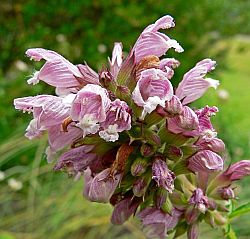 Photo: Stan Shebs | A true, endemic flower of the Canary Islands, this plant is unusual in its genus in that it has compound leaves in three parts. Growing to a height of over one metre, it prefers moist soil and flowers appear in the summer. |

Photo: Stan Shebs
A true, endemic flower of the Canary Islands, this plant is unusual in its genus in that it has compound leaves in three parts. Growing to a height of over one metre, it prefers moist soil and flowers appear in the summer.
Canary Foxglove
| This flower, known in Latin as isoplexis canariensis, is another true indiginous plant of the islands. These days, it is quite rare in the wild and prefers forest areas where it receives both light and shade. Growing up to six feet tall, it can flower right through from March to December, but is at its best in the summer. | 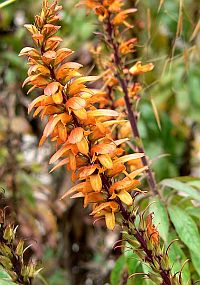 Photo: Stan Shebs |
This flower, known in Latin as isoplexis canariensis, is another true indiginous plant of the islands. These days, it is quite rare in the wild and prefers forest areas where it receives both light and shade. Growing up to six feet tall, it can flower right through from March to December, but is at its best in the summer.

Photo: Stan Shebs
tenerife flora
Canarian Snowball
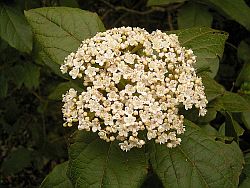 Photo: Frank Vincentz | This quaintly named bush or tree can grow from between two and five foot tall. It is a hardy plant, featuring tough, thick leaves, sporting small hairs on either side. As well as its bundles of white flowers, the plant, later in the year, sprouts purple berries. |

Photo: Frank Vincentz
This quaintly named bush or tree can grow from between two and five foot tall. It is a hardy plant, featuring tough, thick leaves, sporting small hairs on either side. As well as its bundles of white flowers, the plant, later in the year, sprouts purple berries.
Canary Ivy
| Like most types of ivy, this plant is very hardy, growing profusely up walls, around trees and pretty much anywhere else, often covering large areas of ground if left unchecked. Its stems have a reddish tinge and it tends to prefer both light and shade. It uses aerial roots and features the typical three-pointed leaves. | 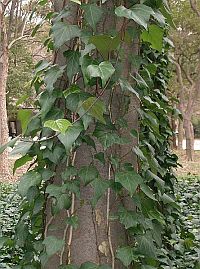 Photo: Kenpei |
Like most types of ivy, this plant is very hardy, growing profusely up walls, around trees and pretty much anywhere else, often covering large areas of ground if left unchecked. Its stems have a reddish tinge and it tends to prefer both light and shade. It uses aerial roots and features the typical three-pointed leaves.

Photo: Kenpei

  follow the TIC on X 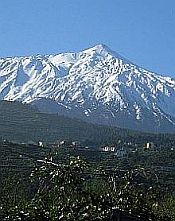 your ad here! Become a site sponsor and have your ad appear on every page. More info.  web business! 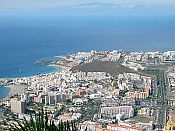 Accommodation 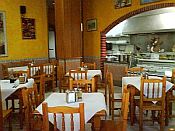 Eating Out 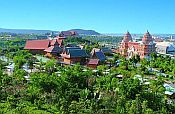 Attractions 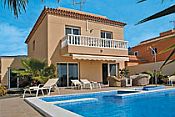 Villas 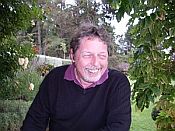 Tell me all your Tenerife experiences |




Facebook Comments
Have your say about what you just read! Leave me a comment in the box below.